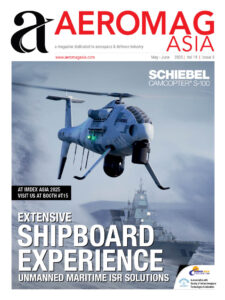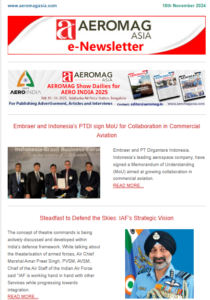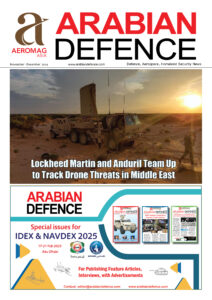
Carl Higgins,
Senior Director of Aerospace and Defense,
Analog Devices
From powering the rapidly growing eVTOL market to enabling highly efficient electrified aircraft and autonomous systems, Analog Devices, Inc. (ADI) is at the forefront of driving innovation that reduces costs, enhances safety, and improves the passenger experience. As the aerospace industry evolves, ADI’s ability to integrate advanced sensors, AI capabilities, and power management solutions positions it as a key enabler of transformative technologies. As Carl Higgins, Senior Director of Aerospace and Defense at Analog Devices, puts it, “ADI, as a major supplier in the aerospace industry, will continue to collaborate on future designs where safety and efficiency are directly addressed by our portfolio of current and future product development.” In this interview, he outlines ADI’s pivotal role in advancing next-generation avionics, autonomous flight systems, and space exploration through cutting-edge semiconductor technology.
Please elaborate on the role of ADI in supporting next-generation avionics and autonomous flight systems?.
The key areas of focus include Future Air Mobility (eVTOL), Autonomy and overall cost reduction. ADI supports these elements enabling highly digitized aircraft, AI capabilities, improved control systems and advanced connectivity.
Driving down costs is achieved through multiple ways such as providing efficient solutions, where multiple components can be integrated into a System in Package (SiP) that reduces SWaP-C. Additionally, high costs come as the result of fuel consumption. Reducing weight by minimizing the use of cables brings value, as pursued by initiatives such as the WAIC initiative.
ADI’s RF transceivers and integrated System-on-Chip solutions are currently under consideration for WAIC connectivity in future commercial aircraft in part because of their low power consumption and wide dynamic range. ADI’s GMSLTM portfolio of products provides unique solutions enabling better and more efficient use of wired resources, contributing to such savings. Additionally, ADI recognizes and supports continuing innovation for on-board diagnostics and predictive maintenance using sensors around the aircrafts and AI. ADI offers reference designs with proven baseline configurations reducing design cycles getting products to market faster.
Lastly, there is industry wide investment in compound semiconductors such as SiC where we see opportunity in high voltage architectures in future avionics.
How is ADI leveraging its semiconductor expertise to push the boundaries of innovation in avionic technologies?
This is being done by working closely with the industry to develop advanced avionics, as well as flight cost reduction, future air mobility and autonomy. We also provide a large range of sensor technologies, as well as the signal chain that reliably brings the sensor information, with high fidelity, all the way to the bits and to the mission computer so that data can be reliably interpreted for smart avionics.
Our technology improves awareness, safety, reduces fuel consumption, and enables predictive maintenance so that downtime of the aircraft is also reduced. Awareness and safety come as a result of our high-speed data converter technology while fuel consumption can be a result of our GMSL technology.
Our WISP sensors can help predict maintenance in various ways. Our technology is also used to enhance the flight experience and entertainment.
How does ADI’s technology contribute to improving the reliability and performance of critical aerospace applications?
It is essential to ensure reliable, high-fidelity transmission from the sensors to computing systems.
Innovations in edge processing, advanced RF and data conversion are driving the development of more efficient aviation technology. Additionally, we’re supporting electrification of aircraft such as actuators and propulsion systems, reducing aircraft weight and replacing cables with wireless connectivity and optimizing power usage with advanced battery management and power distribution systems. We provide high performance microelectromechanical systems (MEMS) and IMUs for robust AHRS and navigation with DO178 and DO254 support for high fidelity signal processing for comprehensive environmental analysis.
You’ve successfully researched, developed, and grown global markets. What key factors do you consider when expanding into new aerospace regions?
We look to see where our technology has the largest impact. This is driven by understanding the overall size of the market both in products we currently offer as well as our development roadmap. Markets are changing rapidly as disruptive technologies are emerging from start-up companies, and countries are eager to indigenize capabilities as quickly as possible.
By collaborating with the entire ecosystem, we enable ADI to better position itself for growth due to our extensive portfolio of products and capabilities and our ability to go beyond components, providing more complete and sophisticated solutions saving time, money and resources for our global customers.
What are the key emerging markets or applications in the US aerospace sector where ADI sees the most potential for growth?
The emerging eVTOL market is growing rapidly. With commercial services already starting to be scheduled, we see production of eVTOL aircraft bringing a new and exciting alternative to travel. Electrification of commercial aircraft will continue to progress, as well as the in-flight customer experience. Demand for greater connectivity and applications while inflight will continue to drive demand in which ADI is an expert.
With the growing emphasis on space exploration and satellite communications, what unique solutions is ADI offering to the US space sector?
ADI has an extensive portfolio of products ranging from RF-to-bits, power management, sensors, signal conditioning, isolation and more. Combined with our capability to provide integrated solutions (SiPs, SoMs) greatly reducing SWaP-C, ADI can provide both standard and customized configurations meeting a wide range of technical requirements.
The commercial and government space markets are moving at a rapid pace across all orbits including low earth (LEO), medium earth (MEO) and geosynchronous (GEO). Our Beamforming, radio frequency and data conversion solutions provide some of the greatest differentiation for communications, radar, and situational awareness applications – playing a key role in phased array antenna technology through Ka band and beyond. Finally, the Direct to Cell market is coming on-line where our transceivers, linear amplifiers, power detectors and silent switcher buck converters are highly regarded.
How is ADI leveraging its expertise in semiconductors to drive innovation in avionics?
ADI is supplying engineers with design and simulation tools to optimize designs. ADIs beamforming ICs, such as the ADAR1000, bring unique and cutting-edge technology to such requirements. Additionally, reducing overall weight, such as minimizing cabling in aircraft, can be achieved via ADIs wireless GMSL portfolio of solutions. This is driven by the Wireless Communications for Safety Related Aircraft Functions (WAIC) initiative.

What role do you see semiconductors playing in shaping the future of aerospace, particularly in areas like communications, navigation, and power systems?
Communications consists of both pilot and customer applications. If we look at the customer side first, this ties into IFC and the overall customer experience. Our GMSL portfolio as well as beamforming ICs brings a new level of in-cabin customer experience at both the user level and SATCOM requirements between the aircraft and LEO satellites. For the pilots, navigation will be critical. Precise, non-jammable navigation technology is critical for passenger/crew safety. Jamming and spoofing of GPS signals is not new.
However, commercial aircraft carriers are recently reporting that their navigation is being affected more significantly in today’s current, complex geopolitical environment as well as North Atlantic routes. Our MEMS group provides leading edge technology that plays in multiple applications, including commercial. We provide high performance microelectromechanical systems (MEMS) and IMUs for robust AHRS and navigation with DO178 and DO254 support for high fidelity signal processing for comprehensive environmental analysis. Regarding power, ADIs portfolio addresses power management, control and power protection. Enabling the replacement of hydraulic, pneumatic, and mechanical power supplies with high power DC sources reduces weight and overall costs of fuel while bringing the ability to retrofit older, less efficient aircrafts.
Please share examples of how ADI has successfully implemented this approach in recent aerospace projects.
ADI is a main electrification ecosystem solution provider. With focus on power consumption reduction, ADI enables capabilities in aircraft while reducing cost of flight. Edge processing for aviation and advanced sensors, efficient power conversion and unrivalled digitization capabilities along with high-speed connectivity are leveraged widely in aircraft systems globally.
From weather radar to battery management systems, power mgmt., IFC, aircraft communications and engine control, ADI brings future technology, today, to both the aircraft designers and customers alike. Given ADI’s power portfolio and its role as one of the top power management suppliers in the industry, our role in distributing power within the aircraft platforms has become predominant.
Looking ahead, what do you believe will be the most transformative technologies in the aerospace industry, and how is ADI positioning itself to lead in these areas?
AI/ML will impact both the airline and customer experience, and software is taking a larger role in the development and function of products.
By combining software development with our legacy of leading-edge hardware, we’re positioning ourselves in multiple ways to meet new and innovative ideas in a collaborative way. For the airlines, predictive maintenance, recognizing atmospheric disturbances, optimizing travel routes will improve safety while saving costs. Regarding the in-cabin experience, customers will have richer, more customized capabilities with enhanced IFC while enjoying smoother, less turbulent flights given the ability to recognize and bypass foul weather whenever possible.
ADI, as a major supplier in the aerospace industry, will continue to collaborate on future designs where safety and efficiency are directly addressed by our portfolio of current and future product development.











